Discover how a bimodal integration strategy can address the major data management challenges facing your organization today.
Get the Report →Reverse ETL: Accessing Data from Your Data Warehouse in Salesforce

We've spoken at length about the benefits of building ETL/ETL (extract, transform, load/extract, load, transform) pipelines to consolidate business data into a warehouse (or other data store) for analytics, security, reporting, and more. In today's high-powered application ecosystem, businesses are also looking to operationalize their data, pulling data from their warehouse into a business system like an ERP (enterprise resource planning) or CRM (customer relationship management). With warehouse data in their operational systems, organizations can apply the insights gained from data analysis directly in their day-to-day operations.
This integration, called "reverse ETL," enhances the CRM, streamlines workflows, and supports real-time decisions, all with an eye towards improving business efficiency and effectiveness.
Reverse ETL can also play a crucial role in data democratization. Pulling warehoused data into business applications ensures that insights are accessible throughout the organization, fostering better decisions by every stakeholder in an organization. Reverse ETL also ensures that the warehoused data conforms to the business application's format, maintaining data accuracy and consistency across platforms while simplifying compliance and reporting processes. This process can also enhance an organization's competitive advantage by providing stakeholders with a comprehensive view of customer engagement, which enables them to build personalized products and services.
Reverse ETL two ways with CData
As we talked about, traditional reverse ETL involves extracting data from a warehouse and loading it into a business application. With the latest CData Sync release, organizations can do just that – pull data from a SQL Server or Snowflake warehouse (with more warehouses to come) and load it directly in Salesforce. Now, businesses can inject all the enriched, centralized, and aggregated data directly into the CRM to not only build a better picture of customers, but take advantage of all the processes, analytics, and reporting available directly from Salesforce.
Learn more about replicating data to Salesforce in CData Sync:
That said, there are situations where it doesn't make sense to use reverse ETL to make warehouse data accessible in an operational app like Salesforce. An example of this scenario is if a customer has a large amount of data they’re trying to provide access to or there are security and compliance requirements.
For instance, CData is working with a small business loan provider who needed access to their Snowflake data directly from Salesforce. Traditionally, this problem can be solved with reverse ETL, but infosec and cost considerations prevented them from moving the data. CData Connect Cloud enabled the organization to build views of part of their Snowflake warehouse and access the data using Salesforce Connect.
Learn how to access live Snowflake data in Salesforce through Connect Cloud in our knowledge base article.
CData + Salesforce: Better together
Whether an organization needs to replicate warehouse data directly to Salesforce or needs live access to their data in Salesforce without replication, CData is here to help. Use CData Sync for reverse ETL or use CData Connect Cloud to solve the reverse ETL problem without replicating the data.
You can start a free trial of either CData Sync or CData Connect Cloud today and see the CData difference for yourself.
Join the CData Community to ask questions, get answers, and collaborate with people who use CData everyday.
Explore CData Sync
Take a product tour today to learn how CData Sync can help you make the most of your Salesforce data.
Tour the product





